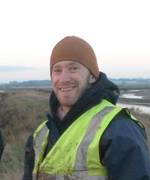Carl Reddin
Dr. Carl Reddin
Reddin, Carl
Forschungsschwerpunkte
- Spatio-temporal patterns in marine biodiversity: importance of common and rare species, sampling effort, environmental stressors
- Marine food web ecology using stable isotopes: influences of coastal upwelling, importance of macroalgae to coastal foodwebs, isotopic niche variation
- Scaling patterns in ecological variables
Forschungsprojekte
-
Temperature-related stresses as a unifying principle in ancient extinctions
(Drittmittelfinanzierte Gruppenförderung – Teilprojekt)
Titel des Gesamtprojektes: FOR 2332: Temperature-related stresses as a unifying principle in ancient extinctions (TERSANE)
Laufzeit: 1. Juli 2016 - 30. Juni 2019
Mittelgeber: DFG / Forschungsgruppe (FOR)
URL: https://www.gzn.fau.de/palaeoumwelt/projects/tersane/index.htmlCombined with local and regional anthropogenic factors, current human-induced climate warming is thought to be a major threat to biodiversity. The ecological imprint of climate change is already visible on land and in the oceans. The imprint is largely manifested in demographic/abundance changes and phenological and distribution shifts, whereas only local extinctions are yet attributable to climate change with some confidence. This is expected to change in the near future owing to direct heat stress, shortage of food, mismatches in the timing of seasonal activities, geographic barriers to migration, and new biological interactions. Additional stressors are associated with climate warming in marine systems, namely acidification and deoxygenation. Ocean acidification is caused by the ocean's absorption of CO2 and deoxygenation is a result of warmer water, increased ocean stratification and upwelling of hypoxic waters. The combination of warming, acidification and deoxygenation is known as the "deadly trio". Temperature is the most pervasive environmental factor shaping the functional characteristics and limits to life and is also central to the generation and biological effects of hypoxic waters and to modulating the effects of ocean acidification, with and without concomitant hypoxia. Due to the key role of temperature in the interaction of the three drivers we termed these temperature-related stressors (TRS).
Publikationen
Beiträge in Fachzeitschriften
- Teichert, S., Reddin, C.J., & Wisshak, M. (2024). In situ decrease in rhodolith growth associated with Arctic climate change. Global Change Biology, 30. https://doi.org/10.1111/gcb.17300
- Hänsel, P., Oehrl, S., Ideström, L., Widerström, P., Reddin, C.J., & Munnecke, A. (2023). Stable carbon and oxygen isotope geochemistry as provenance indicator for the picture stones on Gotland (Sweden). GFF. https://doi.org/10.1080/11035897.2023.2233575
- Kocsis, Á., Reddin, C.J., Scotese, C.R., Valdes, P.J., & Kießling, W. (2021). Increase in marine provinciality over the last 250 million years governed more by climate change than plate tectonics. Proceedings of the Royal Society of London, Series B: Biological Sciences, 288(1957). https://doi.org/10.1098/rspb.2021.1342
- Reddin, C.J., Kocsis, Á., & Kießling, W. (2020). Corrigendum to: Marine invertebrate migrations trace climate change over 450 million years (Global Ecology and Biogeography, (2018), 27, 6, (704-713), 10.1111/geb.12732). Global Ecology and Biogeography, 29(7), 1280-1282. https://doi.org/10.1111/geb.13114
- Reddin, C.J., Nätscher, P., Kocsis, Á., Pörtner, H.O., & Kießling, W. (2020). Marine clade sensitivities to climate change conform across timescales. Nature Climate Change. https://doi.org/10.1038/s41558-020-0690-7
- Reddin, C.J., Kocsis, Á., Aberhan, M., & Kießling, W. (2020). Victims of ancient hyperthermal events herald the fates of marine clades and traits under global warming. Global Change Biology. https://doi.org/10.1111/gcb.15434
- Kocsis, Á., Reddin, C.J., Alroy, J., & Kießling, W. (2019). The r package divDyn for quantifying diversity dynamics using fossil sampling data. Methods in Ecology and Evolution. https://doi.org/10.1111/2041-210X.13161
- Reddin, C.J., Kocsis, Á., & Kießling, W. (2018). Climate change and the latitudinal selectivity of ancient marine extinctions. Paleobiology, 1–15. https://doi.org/10.1017/pab.2018.34
- Reddin, C.J., Kocsis, Á., & Kießling, W. (2018). Marine invertebrate migrations trace climate change over 450 million years. Global Ecology and Biogeography, 27(6), 704-713. https://doi.org/10.1111/geb.12732
- Kocsis, Á., Reddin, C.J., & Kießling, W. (2018). The biogeographical imprint of mass extinctions. Proceedings of the Royal Society of London, Series B: Biological Sciences, 285(1878). https://doi.org/10.1098/rspb.2018.0232
- Reddin, C.J., Bothwell, J., O'Connor, N., & Harrod, C. (2018). The effects of spatial scale and isoscape on consumer isotopic niche width. Functional Ecology, 32(4), 904-915. https://doi.org/10.1111/1365-2435.13026
- Kocsis, Á., Reddin, C.J., & Kießling, W. (2018). The stability of coastal benthic biogeography over the last 10 million years. Global Ecology and Biogeography, 27(9), 1106-1120-1120. https://doi.org/10.1111/geb.12771
- Reddin, C.J., O'Connor, N., & Harrod, C. (2016). Living to the range limit: Consumer isotopic variation increases with environmental stress. PeerJ, 2016(6). https://doi.org/10.7717/peerj.2034
- Reddin, C.J., Bothwell, J., & Lennon, J. (2015). Between-taxon matching of common and rare species richness patterns. Global Ecology and Biogeography, 24(12), 1476-1486. https://doi.org/10.1111/geb.12372
- Reddin, C.J., Docmac, F., Bothwell, J., & Harrod, C. (2015). Coastal upwelling drives intertidal assemblage structure and trophic ecology. PLoS ONE, 10(7). https://doi.org/10.1371/journal.pone.0130789
- Riascos, J., Docmac, F., Reddin, C.J., & Harrod, C. (2015). Trophic relationships between the large scyphomedusa Chrysaora plocamia and the parasitic amphipod Hyperia curticephala. Marine Biology, 162(9), 1841-1848. https://doi.org/10.1007/s00227-015-2716-7

